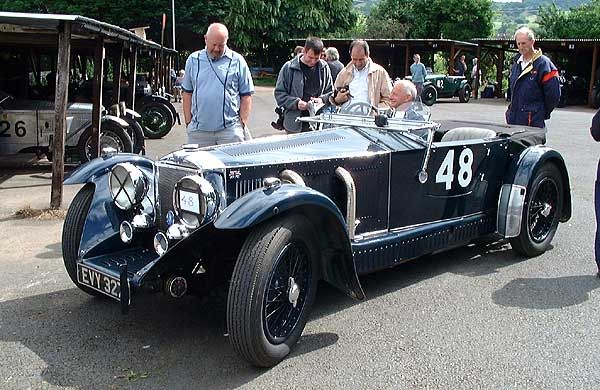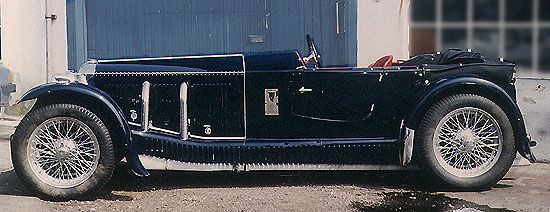Description
The Invicta Type S was one of the most distinguished British sports cars of the interwar period—a magnificent blend of elegance, engineering excellence, and sheer mechanical confidence. Produced between 1930 and 1935 by the Invicta Car Company of Cobham, Surrey, the Type S stood as one of the finest grand tourers of its age, a car that could cover long distances at high speed with the grace and reliability of a true thoroughbred. With its beautifully balanced proportions, powerful straight-six engine, and impeccable construction, the Invicta Type S was not just a car for competition or display—it was a machine built to endure, to travel, and to be driven fast over real roads.
Invicta had been founded in 1925 by Noel Macklin, an engineer and entrepreneur whose goal was to build a British car that could combine the refinement of a Rolls-Royce with the stamina and pace of a Bentley. Working with financier Oliver Lyle of the Tate & Lyle sugar family, Macklin established Invicta as a producer of hand-built, high-quality cars designed for performance and durability. The company’s motto, “Invicta—Unconquered,” summed up its philosophy perfectly. The Type S, introduced in 1930, represented the pinnacle of this ambition. It was the ultimate expression of the Invicta ideal—a powerful, beautifully made sports car for discerning drivers who demanded both luxury and endurance.
The heart of the Invicta Type S was its magnificent 4.5-litre Meadows straight-six engine. Built by Henry Meadows Ltd of Wolverhampton, it was one of the finest power units of its day: a robust, overhead-valve design producing around 100 horsepower in standard form and more in tuned competition versions. The engine delivered immense torque at low revs, allowing the car to surge forward effortlessly from almost any speed without the need for frequent gear changes. Power was sent to the rear wheels through a four-speed gearbox, and the car could reach 95 to 100 mph—a remarkable figure for a machine of its size and luxury in the early 1930s.
The Type S chassis was both advanced and beautifully executed. It featured an exceptionally low centre of gravity thanks to its underslung frame, with the main chassis rails passing below the axles. This design not only gave the car its distinctive low-slung stance but also improved stability and handling, allowing the Invicta to corner with grace and confidence. The wheelbase was relatively short for a grand tourer, at around 9 feet 4 inches (2.85 metres), contributing to the car’s agility. Suspension was by semi-elliptic leaf springs, and braking was provided by large mechanical drums operated by a cable linkage that offered strong, progressive stopping power. The combination of a torquey engine, low-slung chassis, and superb weight distribution gave the Type S extraordinary balance and control for its era.
The car’s appearance matched its mechanical sophistication. The Invicta Type S was a study in proportion and restraint—sleek without ostentation, powerful yet refined. The most famous coachwork was the two-seater “Low-Chassis” sports tourer designed by Carbodies of Coventry, although several other firms, including Vanden Plas and Lagonda, produced equally handsome variations. The long bonnet, gently raked radiator grille, and flowing front wings gave the car a poised, predatory look, while the low stance and tight overhangs emphasized its athletic character. The signature detail of the Type S was its sculpted tail, tapering elegantly behind the cockpit to a subtle point—a hallmark of 1930s British design. The car sat on wire-spoke wheels, often fitted with knock-off hubs and shod with large, narrow tyres suitable for endurance work.
Inside, the Type S was a true grand tourer. The cockpit was intimate but comfortable, trimmed in fine leather and polished wood. The instrument panel featured a full complement of gauges—speedometer, tachometer, oil pressure, ammeter, and fuel level—arranged clearly before the driver. The large, four-spoke steering wheel provided ample leverage, while the long gear lever fell easily to hand. Unlike many stripped-back sports cars of its time, the Invicta offered a sense of quality and craftsmanship that bordered on luxury; even the smallest components were machined to high tolerances and designed for longevity.
What set the Invicta Type S apart from its contemporaries was not just its speed, but its stamina. This was a car designed to cover vast distances quickly and reliably. The company famously demonstrated its durability in 1932, when an Invicta driven by Donald Healey won the grueling Monte Carlo Rally, starting from Stavanger in Norway and covering more than 1,000 miles in winter conditions before arriving in Monte Carlo without mechanical failure. Healey’s triumph cemented the Invicta’s reputation for toughness and engineering excellence, proving that it could perform as well in endurance events as it did on the open road.
Owners of the Invicta Type S were typically among Britain’s most discerning motorists. They were people who valued mechanical quality above fashion—individuals who might have considered a Bentley too heavy or ostentatious, and an MG or Lagonda too small. The car’s exclusivity also added to its allure: fewer than 80 examples of the Low-Chassis Type S were built in total, each tailored to its buyer’s specifications. Every Invicta was effectively a bespoke automobile, handcrafted by skilled artisans at the Cobham works.
On the road, the Type S was—and remains—a revelation. The smooth torque of the Meadows engine delivered unhurried, confident performance, while the low chassis and well-judged suspension gave the car exceptional composure on twisting roads. The controls were beautifully weighted, and the steering, though heavy at low speeds, provided precise feedback once moving. Period testers praised the car for its remarkable blend of comfort, stability, and pace. It could be driven for hours at high speed without fatigue—an achievement few of its contemporaries could match.
Despite its excellence, the Invicta Type S was produced in small numbers, and the company’s high production costs and limited market ultimately led to its closure in 1935. Yet its reputation never faded. Among enthusiasts of pre-war sports cars, the Invicta Low-Chassis Type S is considered one of the finest British automobiles ever built—a car that embodies the best of the country’s interwar engineering and design traditions.
Today, surviving examples of the Invicta Type S are treasured by collectors for their rarity, craftsmanship, and driving experience. They are frequent participants in historic rallies and concours events, admired not only for their beauty but for their exceptional road manners even by modern standards. The combination of low-slung elegance, muscular torque, and faultless mechanical refinement gives the Type S a timeless appeal.
The Invicta Type S stands as one of the greatest sports cars of its age—a car that exemplified everything British motoring aspired to be in the 1930s: fast, durable, understated, and impeccably built. It was, in every sense, a gentleman’s express—capable of crossing continents in speed and silence, and a lasting symbol of an era when craftsmanship and endurance defined true automotive excellence.

